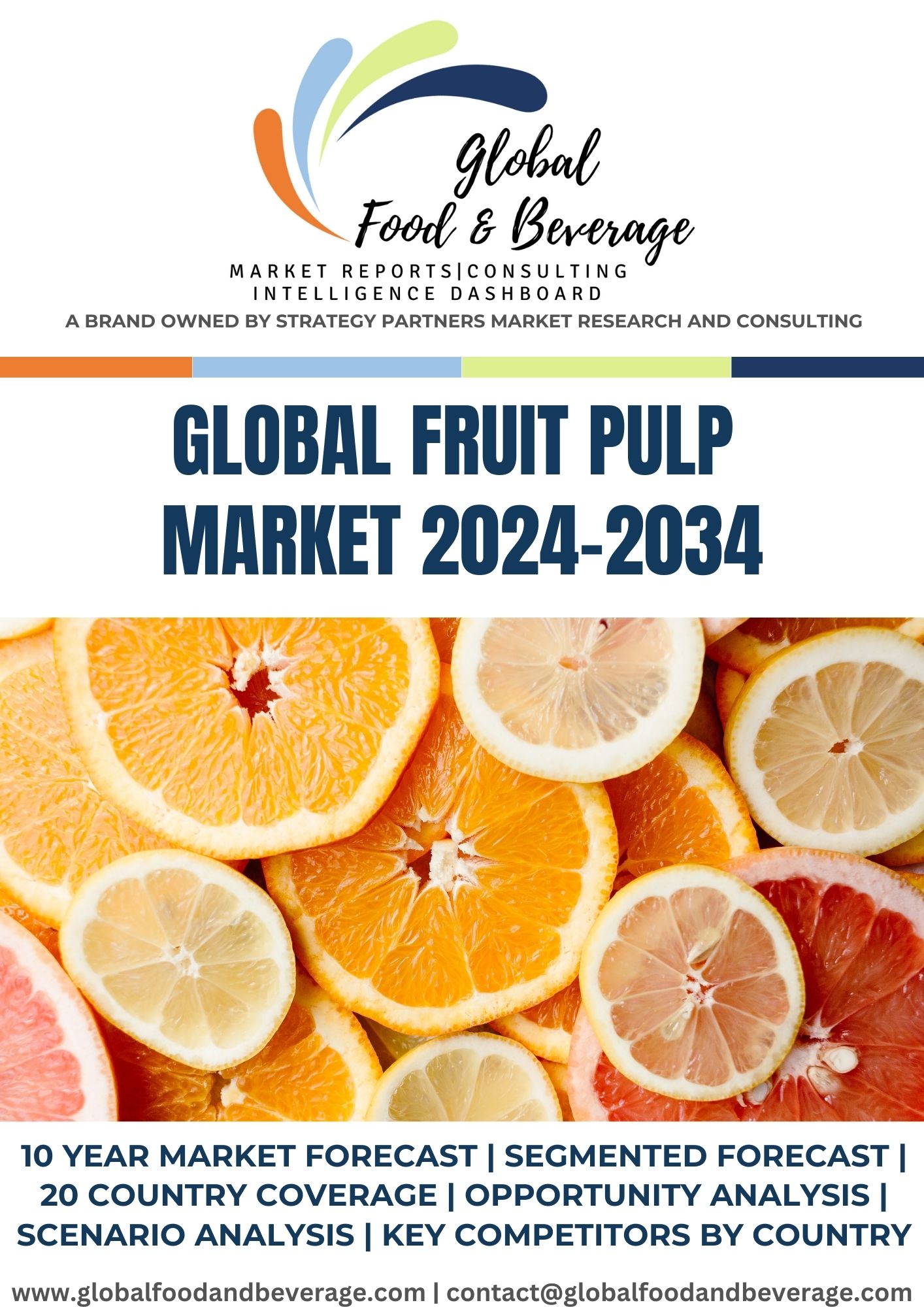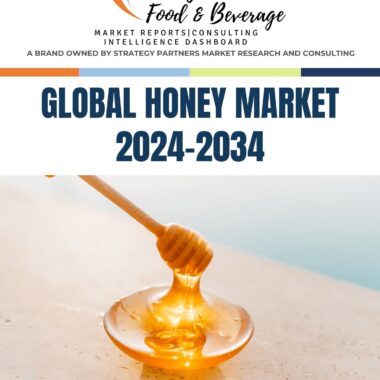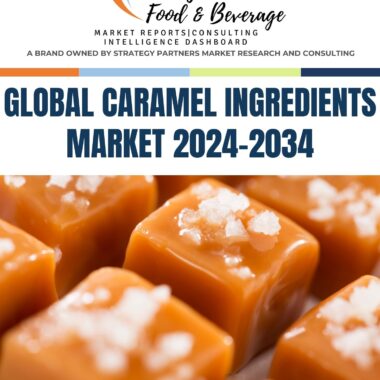Description
The global fruit pulp market is a vibrant and essential segment within the food and beverage industry, contributing to a wide range of products, from fruit juices and smoothies to dairy products, desserts, and baked goods. Fruit pulp is the edible, crushed, and blended flesh of fruits, devoid of seeds and skin, and it retains the natural flavor, color, and nutrients of the fruit. It serves as a versatile ingredient, enhancing the taste, texture, and nutritional value of various food and beverage items. The market’s growth is driven by several key factors, including the increasing demand for natural and healthy food products, the convenience and versatility of fruit pulp, and the global popularity of fruit-based beverages.
One of the primary drivers of the global fruit pulp market is the rising demand for natural and healthy food products. Consumers are increasingly seeking food and beverages made from natural ingredients, free from artificial additives and preservatives. Fruit pulp fits this criterion, as it is minimally processed and retains the inherent nutrients and flavors of the fruit. The perception of fruit pulp as a wholesome and nutritious ingredient has driven its inclusion in various food and beverage products.
The convenience and versatility of fruit pulp also contribute significantly to the market’s growth. Fruit pulp eliminates the need for peeling, pitting, and deseeding fruits, reducing preparation time and waste. Food manufacturers appreciate the ease of incorporating fruit pulp into a wide range of applications, such as fruit-flavored yogurts, ice creams, and bakery items. Its natural sweetness and fruitiness enhance the taste and appeal of these products.
The global popularity of fruit-based beverages is another key driver of the market. Fruit pulp is a fundamental ingredient in the production of fruit juices, nectars, and fruit smoothies, which are consumed worldwide. These beverages offer a refreshing and healthy alternative to carbonated soft drinks and are often perceived as a source of vitamins and antioxidants.
The global fruit pulp market encompasses a diverse range of fruits and their corresponding pulp products, each catering to specific culinary and nutritional needs:
1. **Citrus Fruit Pulp:** Citrus fruits like oranges, lemons, and limes are popular choices for pulp, used in the production of juices and beverages, as well as in confectionery and dessert applications.
2. **Tropical Fruit Pulp:** Exotic fruits like mangoes, pineapples, and guavas are favored for their vibrant flavors and are used in a wide range of products, from fruit juices to ice creams.
3. **Berry Fruit Pulp:** Berries such as strawberries, blueberries, and raspberries are known for their natural sweetness and antioxidant properties, making them popular for smoothies, jams, and bakery items.
4. **Stone Fruit Pulp:** Fruits like peaches, apricots, and plums are processed into pulp for use in fruit fillings, dairy products, and baked goods.
Prominent players in the global fruit pulp market include fruit processing companies, suppliers, and distributors specializing in fruit purees and pulp products. Companies like D?hler GmbH, Kiril Mischeff, and AGRANA Group are key players with a strong presence in the industry. These companies often engage in partnerships with fruit growers and food manufacturers to ensure a consistent supply of high-quality fruit pulp.
Regionally, the global fruit pulp market benefits from the widespread consumption of fruit-based products across the world. However, regions with abundant fruit production, such as Latin America and Southeast Asia, play a significant role in the market’s growth. Countries like Brazil, India, and Thailand are major producers and exporters of fruit pulp, contributing to the global availability of fruit pulp products.
The future outlook for the global fruit pulp market is promising, with several trends and challenges on the horizon. The market is expected to benefit from the continued demand for natural and healthy food products, as consumers prioritize nutrition and well-being. Fruit pulp’s versatility and convenience will continue to drive its adoption in various food and beverage applications.
Challenges in the fruit pulp market include addressing sustainability concerns and managing supply chain disruptions. Sustainable sourcing of fruits is becoming increasingly important as consumers seek eco-friendly options. Supply chain disruptions, such as those caused by transportation issues or natural disasters, can impact the availability and pricing of fruit pulp. Maintaining quality control and adhering to food safety standards is essential to meet consumer expectations and regulatory requirements.
In conclusion, the global fruit pulp market is a vital component of the food and beverage industry, driven by the demand for natural and healthy food products, the convenience and versatility of fruit pulp, and the global popularity of fruit-based beverages. Fruit pulp enhances the taste, texture, and nutritional value of various food and beverage items, contributing to their appeal and consumer acceptance. As the market continues to evolve, manufacturers, suppliers, and distributors will need to innovate and adapt to changing consumer preferences, sustainability concerns, and supply chain dynamics to meet the diverse needs of consumers and the industry.
Table of Content
1 Market Introduction- Global Fruit Pulp Market
1.1 Market Segmentation- Global Fruit Pulp Market
1.2 Key Trends- Global Fruit Pulp Market
1.2.1 Drivers
1.2.2 Restraints
1.2.3 Challenges
2 Global Market Forecast- Global Fruit Pulp Market
2.1.1 By Region
2.1.2 By Type
2.1.3 By Nature
2.1.4 By Form
2.1.5 By Distribution
2.1.6 By End Use
3 Country Wise Forecast- Global Fruit Pulp Market
3.1 US
3.1.1 Key Trends
3.1.2 Consumer Spending
o Population
o GDP
o CPI
o Spend per Capita
o Spend as a proportion of GDP
3.1.3 Market Forecast- US Fruit Pulp Market
o By Type
o By Nature
o By Form
o By Distribution
o By End Use
3.1.4 Key Competitors- US Fruit Pulp Market
3.1.5 EXIM
3.1.6 Patents
3.1.7 Scenario Analysis- US Fruit Pulp Market
3.1.8 Opportunity Analysis- US Fruit Pulp Market
3.2 Canada
3.2.1 Key Trends
3.2.2 Consumer Spending
o Population
o GDP
o CPI
o Spend per Capita
o Spend as a proportion of GDP
3.2.3 Market Forecast- Canada Fruit Pulp Market
o By Type
o By Nature
o By Form
o By Distribution
o By End Use
3.2.4 Key Competitors
3.2.5 EXIM
3.2.6 Patents
3.2.7 Scenario Analysis
3.2.8 Opportunity Analysis
3.3 UK
3.3.1 Key Trends
3.3.2 Consumer Spending
o Population
o GDP
o CPI
o Spend per Capita
o Spend as a proportion of GDP
3.3.3 Market Forecast
o By Type
o By Nature
o By Form
o By Distribution
o By End Use
3.3.4 Key Competitors
3.3.5 EXIM
3.3.6 Patents
3.3.7 Scenario Analysis
3.3.8 Opportunity Analysis
3.4 Germany
3.4.1 Key Trends
3.4.2 Consumer Spending
o Population
o GDP
o CPI
o Spend per Capita
o Spend as a proportion of GDP
3.4.3 Market Forecast
o By Type
o By Nature
o By Form
o By Distribution
o By End Use
3.4.4 Key Competitors
3.4.5 EXIM
3.4.6 Patents
3.4.7 Scenario Analysis
3.4.8 Opportunity Analysis
3.5 France
3.5.1 Key Trends
3.5.2 Consumer Spending
o Population
o GDP
o CPI
o Spend per Capita
o Spend as a proportion of GDP
3.5.3 Market Forecast
o By Type
o By Nature
o By Form
o By Distribution
o By End Use
3.5.4 Key Competitors
3.5.5 EXIM
3.5.6 Patents
3.5.7 Scenario Analysis
3.5.8 Opportunity Analysis
3.6 Italy
3.6.1 Key Trends
3.6.2 Consumer Spending
o Population
o GDP
o CPI
o Spend per Capita
o Spend as a proportion of GDP
3.6.3 Market Forecast
o By Type
o By Nature
o By Form
o By Distribution
o By End Use
3.6.4 Key Competitors
3.6.5 EXIM
3.6.6 Patents
3.6.7 Scenario Analysis
3.6.8 Opportunity Analysis
3.7 Ireland
3.7.1 Key Trends
3.7.2 Consumer Spending
o Population
o GDP
o CPI
o Spend per Capita
o Spend as a proportion of GDP
3.7.3 Market Forecast
o By Type
o By Nature
o By Form
o By Distribution
o By End Use
3.7.4 Key Competitors
3.7.5 EXIM
3.7.6 Patents
3.7.7 Scenario Analysis
3.7.8 Opportunity Analysis
3.8 Spain
3.8.1 Key Trends
3.8.2 Consumer Spending
o Population
o GDP
o CPI
o Spend per Capita
o Spend as a proportion of GDP
3.8.3 Market Forecast
o By Type
o By Nature
o By Form
o By Distribution
o By End Use
3.8.4 Key Competitors
3.8.5 EXIM
3.8.6 Patents
3.8.7 Scenario Analysis
3.8.8 Opportunity Analysis
3.9 Belgium
3.9.1 Key Trends
3.9.2 Consumer Spending
o Population
o GDP
o CPI
o Spend per Capita
o Spend as a proportion of GDP
3.9.3 Market Forecast
o By Type
o By Nature
o By Form
o By Distribution
o By End Use
3.9.4 Key Competitors
3.9.5 EXIM
3.9.6 Patents
3.9.7 Scenario Analysis
3.9.8 Opportunity Analysis
3.10 Switzerland
3.10.1 Key Trends
3.10.2 Consumer Spending
o Population
o GDP
o CPI
o Spend per Capita
o Spend as a proportion of GDP
3.10.3 Market Forecast
o By Type
o By Nature
o By Form
o By Distribution
o By End Use
3.10.4 Key Competitors
3.10.5 EXIM
3.10.6 Patents
3.10.7 Scenario Analysis
3.10.8 Opportunity Analysis
3.11 Sweden
3.11.1 Key Trends
3.11.2 Consumer Spending
o Population
o GDP
o CPI
o Spend per Capita
o Spend as a proportion of GDP
3.11.3 Market Forecast
o By Type
o By Nature
o By Form
o By Distribution
o By End Use
3.11.4 Key Competitors
3.11.5 EXIM
3.11.6 Patents
3.11.7 Scenario Analysis
3.11.8 Opportunity Analysis
3.12 Portugal
3.12.1 Key Trends
3.12.2 Consumer Spending
o Population
o GDP
o CPI
o Spend per Capita
o Spend as a proportion of GDP
3.12.3 Market Forecast
o By Type
o By Nature
o By Form
o By Distribution
o By End Use
3.12.4 Key Competitors
3.12.5 EXIM
3.12.6 Patents
3.12.7 Scenario Analysis
3.12.8 Opportunity Analysis
3.13 The Netherlands
3.13.1 Key Trends
3.13.2 Consumer Spending
o Population
o GDP
o CPI
o Spend per Capita
o Spend as a proportion of GDP
3.13.3 Market Forecast
o By Type
o By Nature
o By Form
o By Distribution
o By End Use
3.13.4 Key Competitors
3.13.5 EXIM
3.13.6 Patents
3.13.7 Scenario Analysis
3.13.8 Opportunity Analysis
3.14 Brazil
3.14.1 Key Trends
3.14.2 Consumer Spending
o Population
o GDP
o CPI
o Spend per Capita
o Spend as a proportion of GDP
3.14.3 Market Forecast
o By Type
o By Nature
o By Form
o By Distribution
o By End Use
3.14.4 Key Competitors
3.14.5 EXIM
3.14.6 Patents
3.14.7 Scenario Analysis
3.14.8 Opportunity Analysis
3.15 Mexico
3.15.1 Key Trends
3.15.2 Consumer Spending
o Population
o GDP
o CPI
o Spend per Capita
o Spend as a proportion of GDP
3.15.3 Market Forecast
o By Type
o By Nature
o By Form
o By Distribution
o By End Use
3.15.4 Key Competitors
3.15.5 EXIM
3.15.6 Patents
3.15.7 Scenario Analysis
3.15.8 Opportunity Analysis
3.16 Australia
3.16.1 Key Trends
3.16.2 Consumer Spending
o Population
o GDP
o CPI
o Spend per Capita
o Spend as a proportion of GDP
3.16.3 Market Forecast
o By Type
o By Nature
o By Form
o By Distribution
o By End Use
3.16.4 Key Competitors
3.16.5 EXIM
3.16.6 Patents
3.16.7 Scenario Analysis
3.16.8 Opportunity Analysis
3.17 China
3.17.1 Key Trends
3.17.2 Consumer Spending
o Population
o GDP
o CPI
o Spend per Capita
o Spend as a proportion of GDP
3.17.3 Market Forecast
o By Type
o By Nature
o By Form
o By Distribution
o By End Use
3.17.4 Key Competitors
3.17.5 EXIM
3.17.6 Patents
3.17.7 Scenario Analysis
3.17.8 Opportunity Analysis
3.18 Indonesia
3.18.1 Key Trends
3.18.2 Consumer Spending
o Population
o GDP
o CPI
o Spend per Capita
o Spend as a proportion of GDP
3.18.3 Market Forecast
o By Type
o By Nature
o By Form
o By Distribution
o By End Use
3.18.4 Key Competitors
3.18.5 EXIM
3.18.6 Patents
3.18.7 Scenario Analysis
3.18.8 Opportunity Analysis
3.19 India
3.19.1 Key Trends
3.19.2 Consumer Spending
o Population
o GDP
o CPI
o Spend per Capita
o Spend as a proportion of GDP
3.19.3 Market Forecast
o By Type
o By Nature
o By Form
o By Distribution
o By End Use
3.19.4 Key Competitors
3.19.5 EXIM
3.19.6 Patents
3.19.7 Scenario Analysis
3.19.8 Opportunity Analysis
3.20 Japan
3.20.1 Key Trends
3.20.2 Consumer Spending
o Population
o GDP
o CPI
o Spend per Capita
o Spend as a proportion of GDP
3.20.3 Market Forecast
o By Type
o By Nature
o By Form
o By Distribution
o By End Use
3.20.4 Key Competitors
3.20.5 EXIM
3.20.6 Patents
3.20.7 Scenario Analysis
3.20.8 Opportunity Analysis
3.21 South Korea
3.21.1 Key Trends
3.21.2 Consumer Spending
o Population
o GDP
o CPI
o Spend per Capita
o Spend as a proportion of GDP
3.21.3 Market Forecast
o By Type
o By Nature
o By Form
o By Distribution
o By End Use
3.21.4 Key Competitors
3.21.5 EXIM
3.21.6 Patents
3.21.7 Scenario Analysis
3.21.8 Opportunity Analysis
3.22 Thailand
3.22.1 Key Trends
3.22.2 Consumer Spending
o Population
o GDP
o CPI
o Spend per Capita
o Spend as a proportion of GDP
3.22.3 Market Forecast
o By Type
o By Nature
o By Form
o By Distribution
o By End Use
3.22.4 Key Competitors
3.22.5 EXIM
3.22.6 Patents
3.22.7 Scenario Analysis
3.22.8 Opportunity Analysis
3.23 Malaysia
3.23.1 Key Trends
3.23.2 Consumer Spending
o Population
o GDP
o CPI
o Spend per Capita
o Spend as a proportion of GDP
3.23.3 Market Forecast
o By Type
o By Nature
o By Form
o By Distribution
o By End Use
3.23.4 Key Competitors
3.23.5 EXIM
3.23.6 Patents
3.23.7 Scenario Analysis
3.23.8 Opportunity Analysis
3.24 Singapore
3.24.1 Key Trends
3.24.2 Consumer Spending
o Population
o GDP
o CPI
o Spend per Capita
o Spend as a proportion of GDP
3.24.3 Market Forecast
o By Type
o By Nature
o By Form
o By Distribution
o By End Use
3.24.4 Key Competitors
3.24.5 EXIM
3.24.6 Patents
3.24.7 Scenario Analysis
3.24.8 Opportunity Analysis
4 Opportunity Matrix- Global Fruit Pulp Market
5 Conclusions and Recommendations- Global Fruit Pulp Market
6 About Global Food & Beverage




